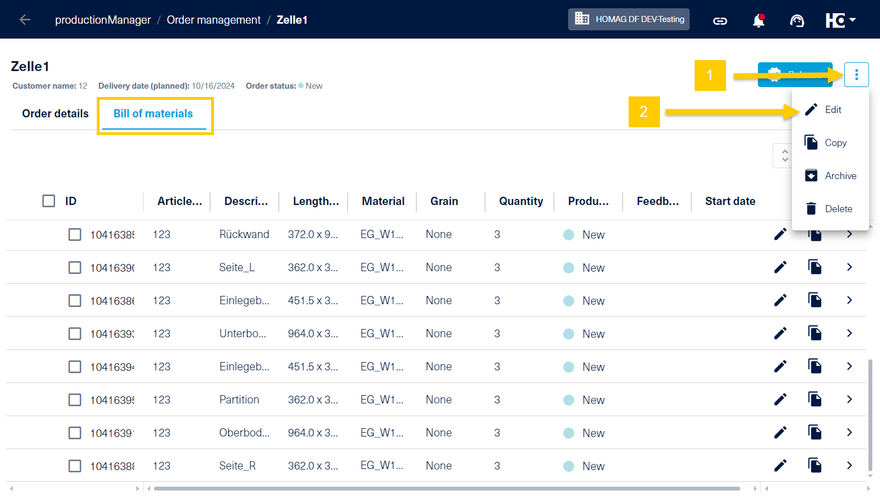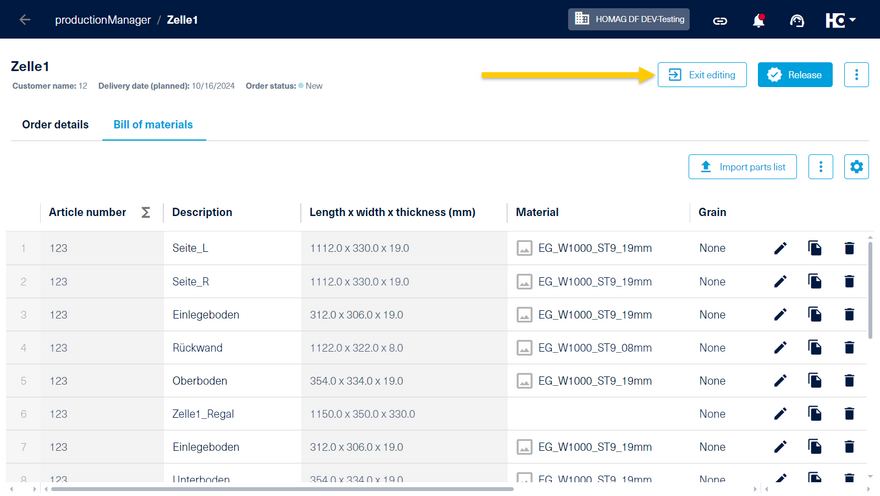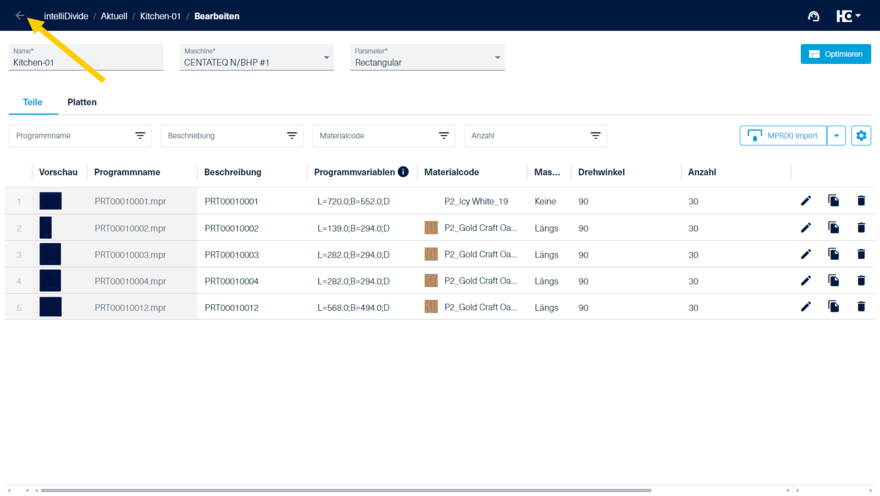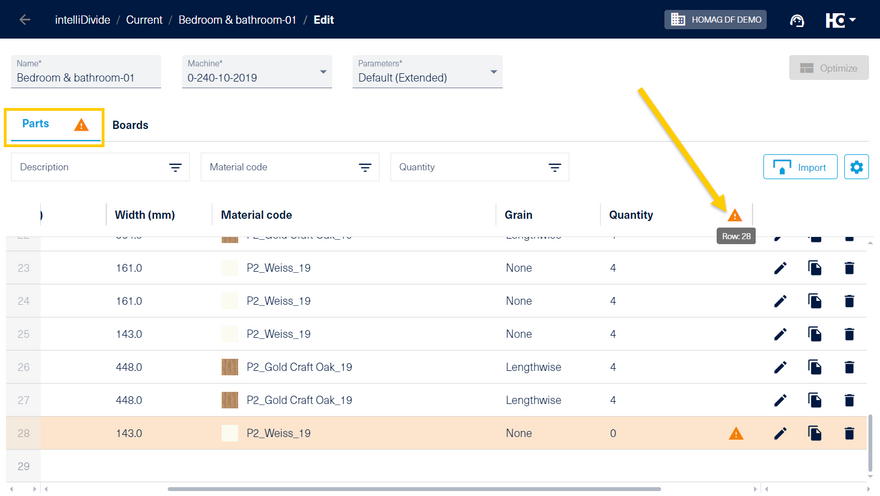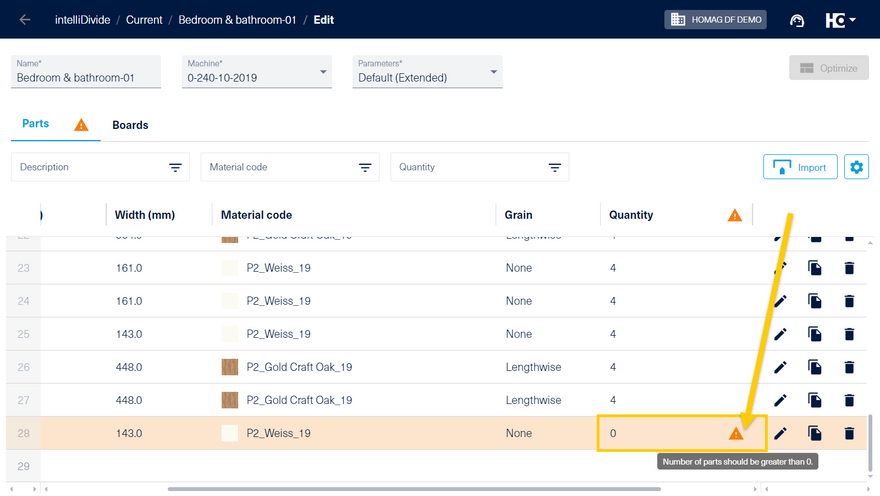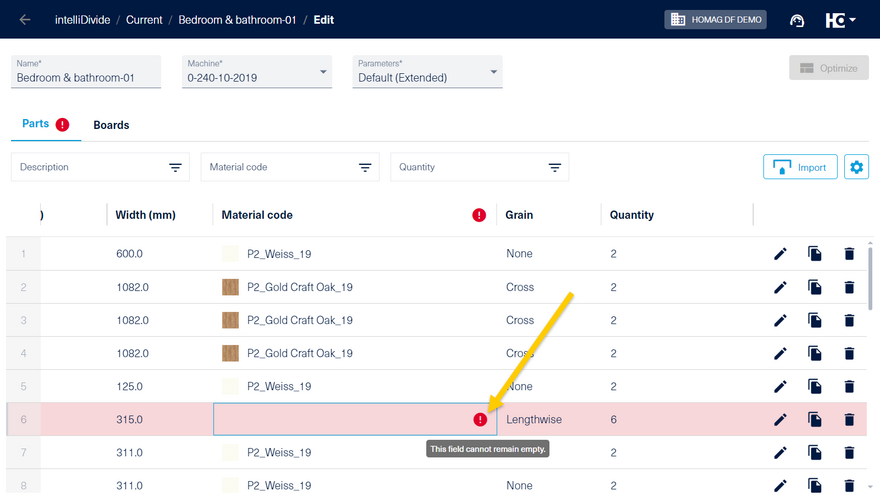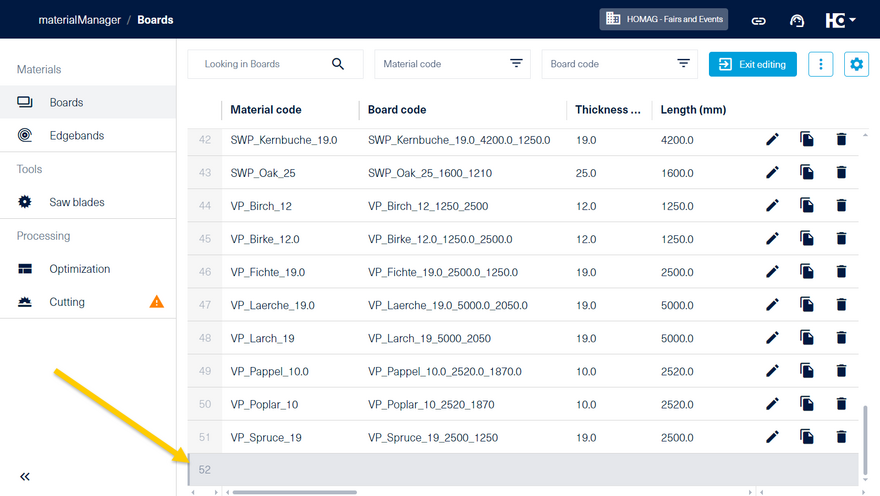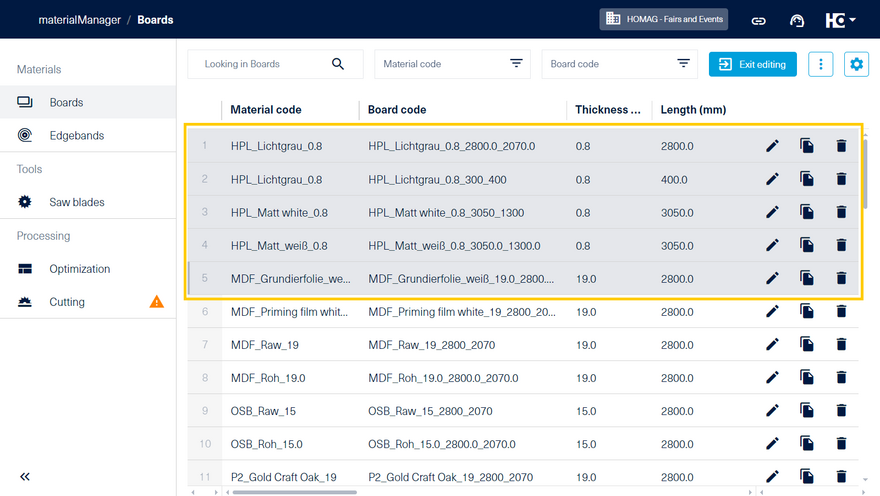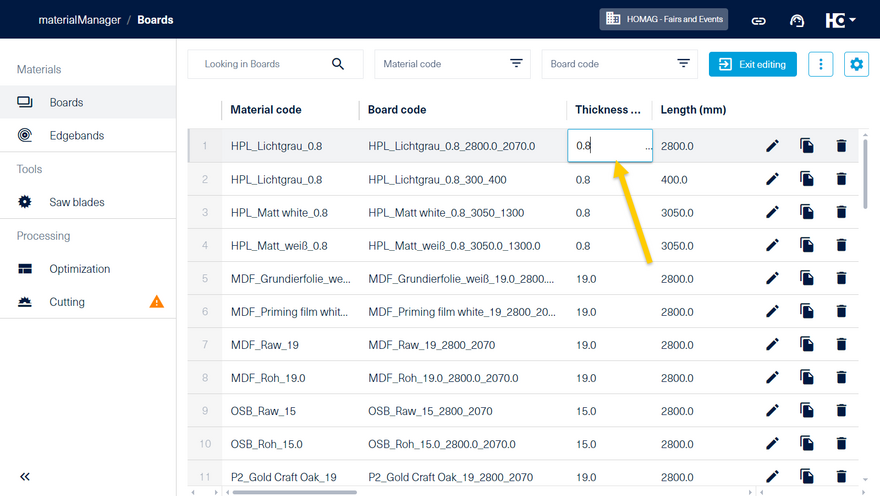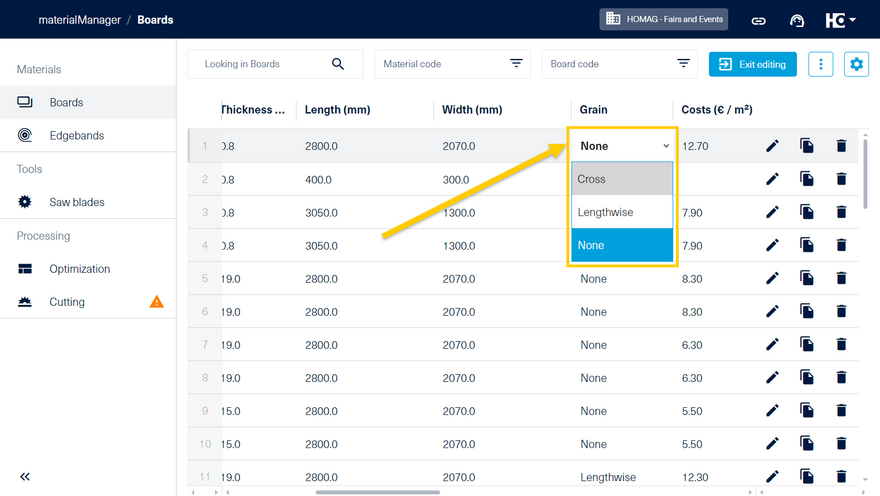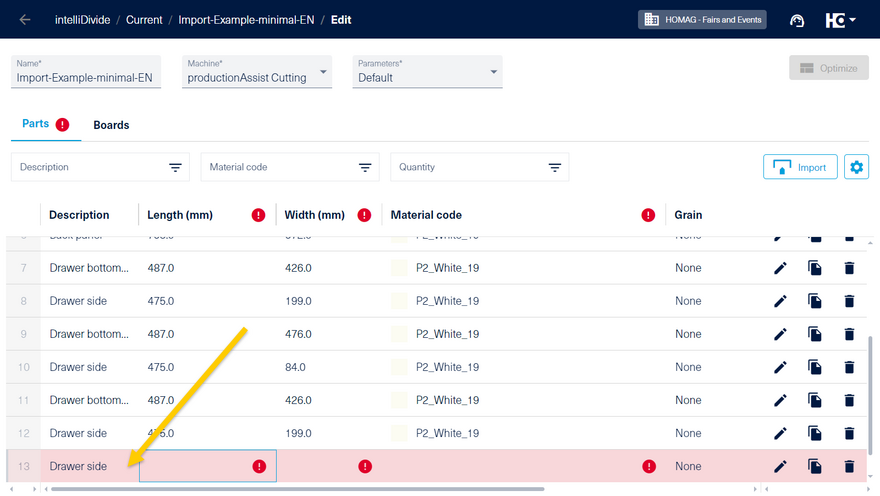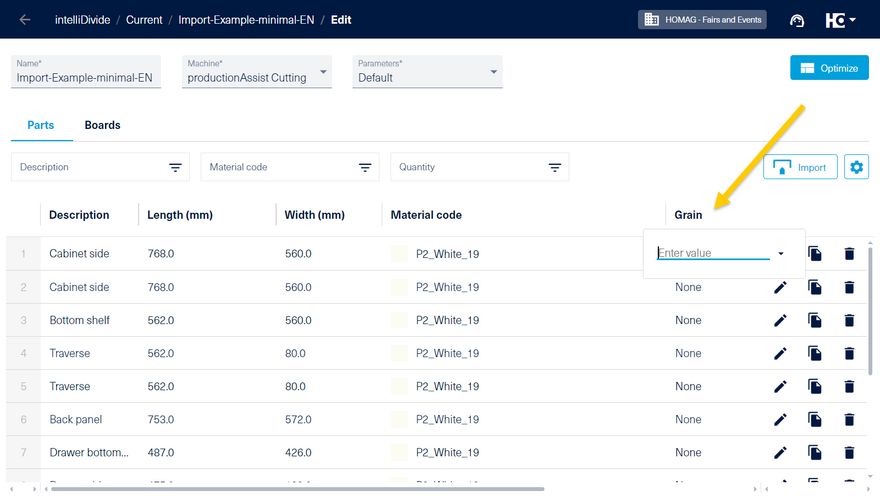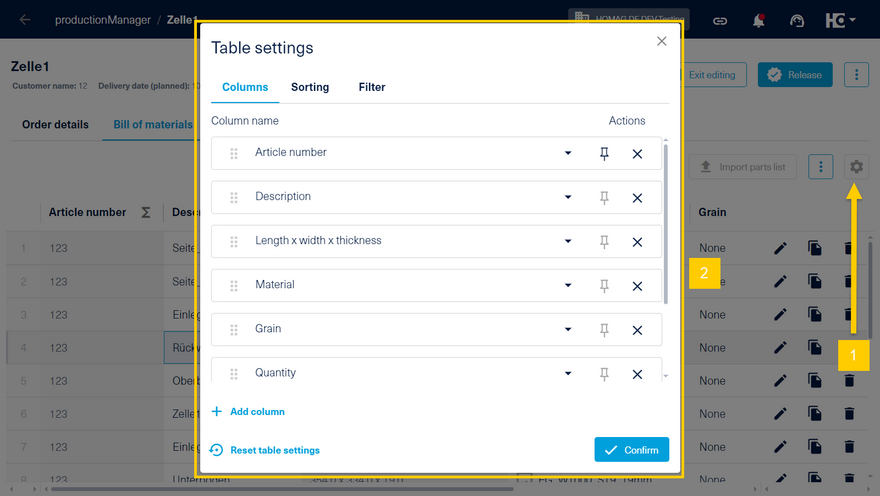Edit Grid
In the table overview, the data can be comprehensively edited in every application. Essentially, the editing of the lists is identical for all applications, but there are specific features for some applications.
Switch to the edit mode in the materialManager
Switching to edit mode in the parts list in productionManager
Exiting the editing mode in the parts list in productionManager
Editing the parts list in intelliDivide
Exiting the editing mode in intelliDivide
Simple troubleshooting
Troubleshooting is very easy. Warnings are marked with a yellow triangle. In contrast to errors - marking red circle with a white cross - they do not necessarily have to be corrected.
Errors in a column are indicated directly in the header of this column by a symbol - a red circle with an exclamation point in it. So there is no need to search through all columns laboriously, but incorrect or missing entries are immediately visible at a glance. This is especially useful when projects with extensive tables have to be processed.
In addition, incorrect rows or rows in which necessary entries are missing are colored light red. Rows with warnings are colored light yellow.
Helpful Tooltips
If you hover the mouse over the column header, a pop-up or tooltip displays the incorrect cells with the corresponding numbering. The same applies to cells in which data is still missing.
If the mouse pointer is moved over the fields marked as incorrect, the user is informed about the necessary information.
If the mouse pointer is moved over a row that contains incorrect or missing information, a tooltip will show in which cells of this row entries or corrections are necessary.
If all errors in a row have been corrected, this row is displayed in white color.
Copy & Paste
Copy & Paste works throughout the tables. By clicking on the line numbering the line is marked. By pressing Ctrl+C the contents are copied to the clipboard and can then be pasted into an Excel table by pressing Ctrl+V. If there are fields in the row that are not filled in, they will be copied into the Excel table as a blank space.
This way you can also copy the values of several rows or all rows into an Excel table.
The reverse direction - importing data from an Excel spreadsheet - also works, of course.
The rows inserted by Copy & Paste are written to the database immediately after the paste operation. In this very short period of time, these contents cannot be edited.
Simple editing of cells
Cells can be edited simply by clicking on the cell. If the cell content is of text format, text-based information can be added to the existing label. This means that the existing value or designation is not deleted but added. This is practical because, for example, many codes are the same and differ only in the last few digits.
However, when changing numerical information, such as the length, the old value is replaced by the new one, i.e. overwritten, because this is more convenient for the user in this case.
Useful key commands and menus
Common key assignments are also implemented in the HOMAG Apps. The selected cell can be edited by pressing F2. If the new value has not yet been confirmed with the Enter key, it can be reset to the original value by pressing the ESC key.
Some columns, such as Grain, have a drop-down menu for selecting parameters. In the other columns with drop-down menu, parameters can be selected, such as category or coating.
Additional comments and files can be stored in the Additional Data tab of the Edit dialog.
If you want to assign an identical value to several cells in a column, you can use the key combination Ctrl+D. This causes all previously selected cells to receive the value of the topmost cell.
The Tab key can be used to copy the contents of the overlying cell to an empty cell.
With a right mouse click on a cell, a dialog pop-up opens in which the new value for the cell can be entered. This also applies to several previously selected cells. If a different value is entered for the topmost selected cell, this value is automatically copied to the other selected cells.
If a new name is entered in a cell, it is immediately available as a suggestion in the drop-down menu in the other cells of the same column.
Selected cells can be easily deleted using the Delete key (Del).
Several selected rows can also be deleted with the Delete key. The deletion process must first be confirmed in a pop-up window (Confirm deletion).
Adding and editing columns
In general, additional columns can be added to the standard view. In productionManager, for example, with Additional data, an additional column is defined in which graphic representations of the product, material, packaging and other additional information can be displayed and downloaded by double-clicking on the corresponding thumbnail.
Calendar entries are also possible. By clicking on fields in the columns of type date, a calendar field appears as a pop-up from which the corresponding data can be easily selected.
When adding new columns, it is also possible to automatically assign values to the cells that cannot be changed by the user in the list view. These values can also be copied into an Excel table, but they cannot be changed there either.
Tip for power users: The tables can be edited almost without a mouse and only with the keyboard.
More shortcuts
Navigation
Keys | Action |
Ctrl + Right Arrow | Navigate/focus last cell (often a button) |
Ctrl + Left Arrow | Navigate/focus first cell |
Ctrl + Up Arrow | Moves to the first row |
Ctrl + Down Arrow | Moves to the last row |
Page Up | Goes one page up (a page ~30 rows) |
Page Down | Goes one page down (a page ~30 rows) |
Tab | Navigated to the next Cell Copies the Cell Value from above |
Home | Navigate/focus top left cell |
End | Navigate/focus bottom right cell |
Editing:
Keys | Action | Custom Action |
Character Key press |
| Adds the key pressed into the cell value |
Numeric Key press |
| Adds the numeric key pressed into the cell value |
Backspace |
| Deletes the first character from the cell |
Enter |
| Gets the cell in editing mode |
F2 | Gets the cell in editing mode |
|
Delete |
| Deleted the content of the cell |
Escape | Editing a cell and then pressing escape will discard the changes |
|
Ctrl + D | Range Select Cells + Ctrl + D will copy the first range cell value to all |
|
Selection:
Keys | Action |
|---|---|
Space | Selected the row |
Ctrl + Click Row Index | Selects the row/s |
Shift + Click Row Index | Selects the range rows |
Ctrl + A | Selects all the rows |
Shift + Arrow Keys | Selects cells in the range |
Mouse Down Range selection | Selects the cells in the range |
Range Selection + Key | Edits only cell from where the range started |


